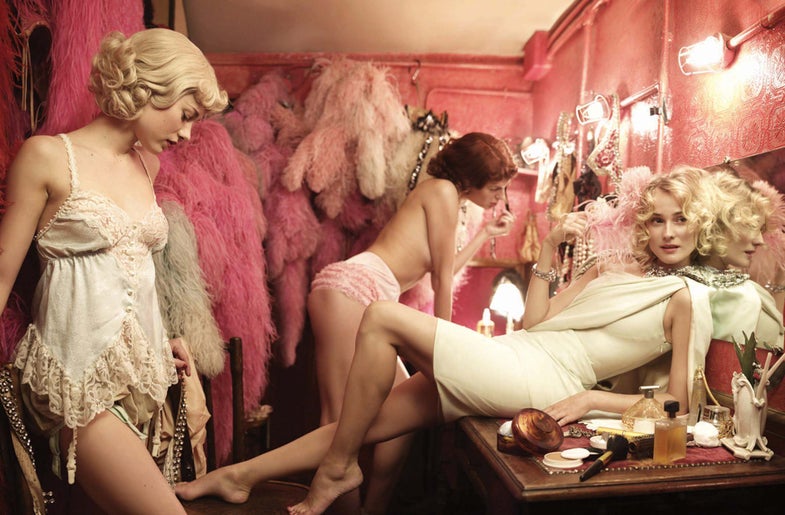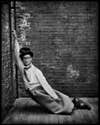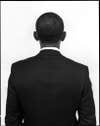Can’t Stop, Won’t Stop: Mark Seliger’s Portraits
Here’s how a kid from Texas became a master














On November 4, 1984, Mark Seliger, all long limbs, wide eyes, and 24-year-old energy, arrived in New York City, where he began an extended stay at his brother’s place in Brooklyn. “I would get up in the morning, get on the train at 6 a.m., make it into the city, and have a coffee,” he says. “Then I’d start plugging dimes into the phone booth.” Every dime was a cold call to a photographer. He’d keep at it until one of them agreed to let him come and assist.
[Related: 6 Former Mark Seliger Interns and Assistants on How He Jumpstarted Their Careers]
Seliger is known for a work ethic that borders on terrifying. His is the kind of intensity that can’t be forced—not continuously for 30 years, anyway. And while that kind of drive can only come from inside, it’s hard not to see in it echoes of Fred Damon, the photographer Seliger did printing for during and after his senior year in high school. Damon, a veteran of Houston’s grip-and-grin circuit, would shoot anything: dinners, industrial work, conventions. If the money was green, he was there.
“Fred was a hard-working photographer in every sense of the word,” Seliger says. When the guy wasn’t shooting he was talking about shooting. Until 2 a.m. sometimes, when he’d fall asleep in his chair, a lit cigar in his hand. As far as the teenager knew, this was just the way photography got done. “I didn’t know there was life outside of what Fred Damon did,” he says.
Today, Seliger shoots for the world’s top culture and fashion magazines. His art pieces hang in galleries, and he is responsible for some of the most iconic celebrity portraits of our time. Look closely and you can see Fred Damon whispering in his ear: Get out there and do the work. Do it until you fall asleep in your chair. Then get up and do some more.
After studying photography in college and a brief stint assisting in Houston, Seliger’s horizons remained small. “I thought I was going to stay in Texas and do annual reports,” he recalls, figuring he’d creatively satisfy himself with personal side projects in his off hours. He had no idea that the wider world of editorial, fashion, or fine art photography existed.
But as he mastered the local scene, the feeling he was moving in the wrong direction grew. “I was at a dead end,” he says. “I didn’t know what else to do.” When a college friend and a coworker both suggested he go to New York for six months, he figured, why not?
An avalanche of dimes later, Seliger had assisted a crazy-quilt assortment of New York City photographers. Boredom wasn’t an issue. “I had a master list, and went and saw whoever would let me,” he says. “Everybody from still life to editorial.” As they worked, he absorbed every detail. Some were extremely technical. Others emphasized aesthetics but couldn’t set up an umbrella to save their lives. They all had something to show him.
Seliger eventually settled into a long-term assisting gig with John Madere, a corporate and advertising shooter and utter perfectionist. Under Madere, Seliger learned “to be persnickety and particular” as well as how to manage clients and stay on top of billing. “It was much better than grad school,” he says of the experience. After a year and a half, however, that old restless feeling crept back in. He was ready to go out on his own.
Daunting though it was, it was time for Seliger to start showing his work. To strengthen his resolve, he eventually stopped assisting completely. It was succeed or starve, and the city didn’t seem to care much about which way it went.
Seliger put together a portfolio and began dropping it off at magazines around the city. It was 1986, and he remembers picking up his portfolio from Avenue magazine down to the exact wording of the note that came back with it: “‘We appreciate your consideration for dropping your work off at the magazine, but I don’t see a sense of personal style here,'” he recites from memory. Its sting is still apparent three decades later. “I had to reread that to make sure I understood what I was seeing. Then I went home, ate five chocolate doughnuts, and sat in the corner.”
The next day he was back on the train. This time he dropped his book off at Forbes, where it found a more receptive audience. “The photo editor sent me the kindest note,” he says, something like “I love your work, and you’d be great here.” The same afternoon he got it, someone called him with an assignment to shoot an executive from Porsche’s U.S. operation.
While the job went well and led to more work for Forbes and other business mags, success became a matter of dogged pursuit. “It was not uncommon to have a couple weeks go by where I dropped off my portfolio every day and never heard the phone ring,” Seliger says. But he didn’t give up. He steadily connected with more and more photo editors, and less than a year after going out on his own, Seliger was making a living from editorial photography. And the mainstream entertainment magazines were beginning to take notice.

“When I found my way into pop culture, it was just an endless sea,” Seliger says of this period. “Suddenly I could do everything from music to actors to models, everything you could possibly imagine.” And imagine he did. Throughout the late 1980s, Seliger turned in stellar shoot after spectacular shoot, blending pathos with humor and a wellspring of humanity to blaze a trail through the upper ranks of the elite magazine world. Visual consultant Laurie Kratochvil, Rolling Stone‘s director of photography at the time, recalls seeing his portfolio after he dropped it off the first time. “I just really enjoyed the way he perceived things,” she recalls. “They seemed spontaneous, not like a forced setup. And they were very well executed technically. Not overlit or overproduced. I said, ‘Hold on to this book. I want to meet this guy.'”
Seliger’s first assignment for Kratochvil demonstrated the meticulousness that was rapidly propelling him to the top of his profession. “When I gave him his first assignment, he did a dress rehearsal,” says Kratochvil. “He did the assignment before he did the assignment! His work ethic was as high as his creative level. It’s very unusual to see that. I think Mark had always wanted to work for Rolling Stone and he wasn’t going to let this opportunity escape.”
Over the following five years, Seliger shot more than a dozen Rolling Stone covers. The magazine realized this unbroken string of hits was no accident, and in 1992 Seliger was signed to a position as a staff photographer. “When you get a talent like Mark’s you just want to feed it,” says Jann Wenner, the magazine’s founder, editor, and publisher. “You just want to give it opportunities and let it grow.”
When Seliger joined RS, his desire to learn continued unabated, and joining the magazine full-time enabled him to turn growth into an art form all its own. His work over the next 10 years put the industry’s collective jaw on the floor in its creative trajectory, sheer proliferation, and impact. The photographer estimates he did at least 100 assignments a year for Wenner Media magazines:* Rolling Stone*, Us Weekly, and Men’s Journal.
“Rough patches happen to everybody—writers, painters, photographers,” says Jodi Peckman, Rolling Stone‘s creative director. “But if Mark has them, we don’t know about it.” Peckman accompanied Seliger on many of the shoots during this period. “His technical chops are top notch, but he’s an ideas guy too. It was clear from the very beginning that he was going to be not only a great cover shooter, but a great prolonged cover shooter,” she says. “If you send Mark back to the same subject, he’ll get something new. You can’t do that with too many photographers. From the beginning he had different styles. But somehow they’re cohesive and they work together.”
Indeed, from the beginning Seliger has shown an uncanny ability to build the ideal shoot for each subject using a mix of highly detailed planning and preparation as well as a willingness to go with the flow on the day of. “He has a way of talking people into things,” says Kratochvil, recalling a shoot with Dana Carvey where Seliger’s idea was to shoot the comedian with a goldfish tail hanging out of his mouth. When Seliger approached Carvey with the idea, the comedian replied, “I’ll do it if you’ll do it.” Seliger didn’t hesitate. And another classic cover was born.
Of course, not every celebrity is ready to eat a goldfish. Or, say, listen to you at all. After a long string of successes, achieved by driving hard at his subjects and controlling so many details of his shoots, Seliger was memorably brought up short while shooting Nirvana in Australia for the band’s first Rolling Stone cover. “I found a great location in the back country west of Melbourne,” he recalls. Then, before the shoot Seliger made the mistake of telling the band to please not wear shirts with any writing on them. Famously, Cobain showed up wearing a shirt that read corporate magazines still suck, along with a chunky pair of plastic sunglasses.
“I said, ‘Can we take a couple without the shirt and glasses?'” Cobain refused, Seliger says. “He finally did two frames without the glasses, but he crossed his eyes. I was so mad at myself for bringing it up to them. I couldn’t let it go.” However, when he returned with the film, Rolling Stone was ecstatic.
“I messed up, but the gods smiled on me. They gave me a pass, and the band was open the next time I shot them. The first cover showed a sense of reluctance and irreverence that was the beginning of something. It was the ’90s. It was noise. After that I started to think about artists very differently I stopped controlling things as much.”
The gods would smile again, as if to show Seliger he was on the right track. Cobain seemed to appreciate that the photographer hadn’t balked at his shenanigans. The next time Seliger shot the band, after the debut of In Utero, the vibe was far more cooperative. In a nod to the previous shoot, Seliger suggested the band wear Brooks Brothers suits for the shoot and they complied. “Then Kurt sat very quietly for me and gave me that Polaroid,” Seliger says, referring to the devastating portrait (page 45) taken just before his death. “There is an honesty and a total melancholy present there. It was a great gift from him and an important lesson for me to learn. That photo was a game changer for me.” While he remained (and remains) meticulous and prepared to a fault, from that point on, collaboration trumped control.
Seliger’s cheekiness didn’t leave completely, of course. He recalls a gamble that paid off during a Rolling Stone shoot in 2010 with President Obama. The magazine needed a conventional cover shot, but Seliger also wanted one “to take home” (something he tries for at every shoot). In this case, his heart was set on a photo of both the front and the back of the president’s head. “When you have five hours you can try different things,” he says. But “when you’re shooting the president of the United States in the White House you have six and a half minutes.” Working in front of Obama’s staff, along with Jann Wenner, a couple of writers, and Seliger’s editor, he shot the cover in about five minutes, then grabbed his Pentax and took the president over to a white background he had set up. “I told him I wanted to do a diptych, so I shot a couple frames from the front, then asked him to turn around,” Seliger says. “After about five frames he said, ‘OK, that’s enough art.'” The whole episode took a minute and a half, but the photo may outlive them both.

In 2002 Seliger left his position at Rolling Stone and began shooting for other magazines: Vanity Fair, GQ. He also began shooting more in fashion and advertising. Those who might mistake this for dabbling are directed to the exceptional work he’s been quietly pumping out for German, Italian, and Spanish Vogue, Ray-Ban, or Levi’s. Or if you prefer, the movie posters for “Anchorman,” “Superbad,” or “The Interview.” It’s as if, after a couple decades of hitting home runs, he decided he’d show up at the stadium Monday night and throw a few touchdown passes, then drop in at the Staples Center to start for the Los Angeles Lakers.
Through it all, Seliger’s personal work has remained not only an intense focus for him but has drawn the kind of outside interest and acclaim most photographers only dream of. Any photographer who maintains such a grueling commercial pace could be forgiven if they wanted to leave their day job at the office. But Seliger sees his personal work as key to his continued growth. “Mark is absolutely crazy like that,” says photographer Patrick Randak, Seliger’s former first assistant, of his old boss’s seemingly inexhaustible creative energy. “If it isn’t a book project, it’s a fine art project or Rusty Truck [Seliger’s alt-country band]. The guy goes a mile a minute. There’s no rest for the weary.”
His monograph When They Came to Take My Father was released in 1996 and features Seliger’s photographs and narratives from holocaust survivors. In My Stairwell (2005) is a collection of stripped-down portraits of cultural figures and artists that Seliger captured over a period of years in the exposed-brick stairwell of his West Village studio. In 2006 he rented a space in the building next door and built a darkroom so he could experiment with making platinum/palladium prints. Then he started a nonprofit gallery, 401 Projects, in the same space with two collaborators. In 2013 Ovation debuted “Capture With Mark Seliger,” a TV show that pairs pro photographers with celebrities who are also photo enthusiasts and explores their work.
Getting closer to darkroom printing, he says, led directly to his next set of personal work, 2010’s book Listen. As he explored, he found himself in need of subject matter that would do justice to the tonal depth platinum/palladiums can achieve. Where his portrait work is about high-level planning and high-wire interpersonal work, the landscape, still life, and nude work in Listen has more to do with serendipity and patience. “A lot of those photos were about slowing down,” he says. “They were about being present and allowing something to come to you rather than you going to it.”
Kratochvil says she’s noticed the shift in his shooting over the past 10 years and ascribes it to an increasing confidence and the calm that generates. “I think he feels a lot more secure about stripping away all the razzamatazz and getting down to basics,” she says. “I think he felt a need to make his pictures simpler—when he did that they got even stronger.”
Seliger recalls when his thinking about the Listen photos gelled. On an unseasonably warm New Year’s Day he was out near his studio when a fog began rolling in around the pylons of a disused pier on the Hudson: “I was just standing there with my Toyo 4×5 looking at the scene unrolling in front of me as the fog was changing. I was watching it very quietly, only shooting every 15 seconds or so. When I looked behind me there were 10 people there. It really affected me that we were all watching the same thing, and it made me want to go and search out these photographs. I thought if these people were enjoying the same thing I was enjoying, it would make a great photographic project.”
Close up, Seliger’s platinum/palladium prints have a luminous, tactile, almost three-dimensional quality, as if the viewer might walk into them. This is not the kind of work that just happens. It is the product of an artist whose primary goal is not to impress, or even to express, but to grow. His focus has remained constant, not on the surfeit of accolades he’s inspired or his financial well-being, but on working as hard as he can while also letting go. It requires that most delicate balance of relaxed attention, maintaining what Zen students call “beginner’s mind.” Where others might feel they have arrived, as far as Mark Seliger is concerned, the journey still very much lies ahead. “He’s still as curious, still as hungry, as he was when I first met him in 1987,” says longtime collaborator (and GQ design director) Fred Woodward. “He’s still most excited about the next picture.”